Dive Sites
Garden of Eden Dive Resort
Experience some of the best diving in the Philippines!
More than 30 different dive sites!
Our Dive Sites
The island of Mindoro lies southwest of Luzon and is divided into two provinces, East and West Mindoro. The coastal areas are inhabited, while only a few tribes live in the forested and mountainous interior. Fishing, rice cultivation, and coconut plantations are the island’s main agricultural activities.
For almost 50 years, Puerto Galera has attracted scientists studying the ecostructure of microorganisms, animals, and plants. The university’s Marine Biology Institute was founded in 1934, and in 1974, UNESCO declared the area a research center and the reefs a protected area. While other areas are designated as marine protected areas, allowing divers and fishermen to do as they please, the nature reserves in Puerto Galera are monitored.
Diving is diverse. There is everything from easy dives for beginners to extreme diving in strong currents.
The opportunities for macro photographers are praised. Nudibranchs, flatworms, and other small, rare creatures compete with one another. But there are also larger photo opportunities. These include stone and table corals, gorgonians, barrel sponges, and whip corals. The reefs constantly change with the tides and the seasons. Diving is possible year-round. All dives are drift dives, meaning there’s no need to swim back to the boat. The boat picks up the diver at the end of the dive. Snorkeling is possible on most reefs.
1. MANILA CHANNEL
Location: West of Garden of Eden Dive Resort
Access: Approx. 20 minutes by boat
Diving experience: From beginners to experienced divers
Average depth: 12 m.
Maximum depth: 24 m.
The reef near the shore features 2 m rocks and a small flooded motorboat. Follow the coral rubble and sand along the edge of a 2-3 m drop-off. Lush hard and soft corals, predominantly beige species, grow above the drop-off. Large blocks of hard corals, some sea fans, and bubble corals are found everywhere. Various sea anemones with clownfish, stippled sea cucumbers, colorful feather stars, tube worms, and many small fish. A blue-spotted stingray occasionally lies in the sand. The reef edges are good for snorkeling.
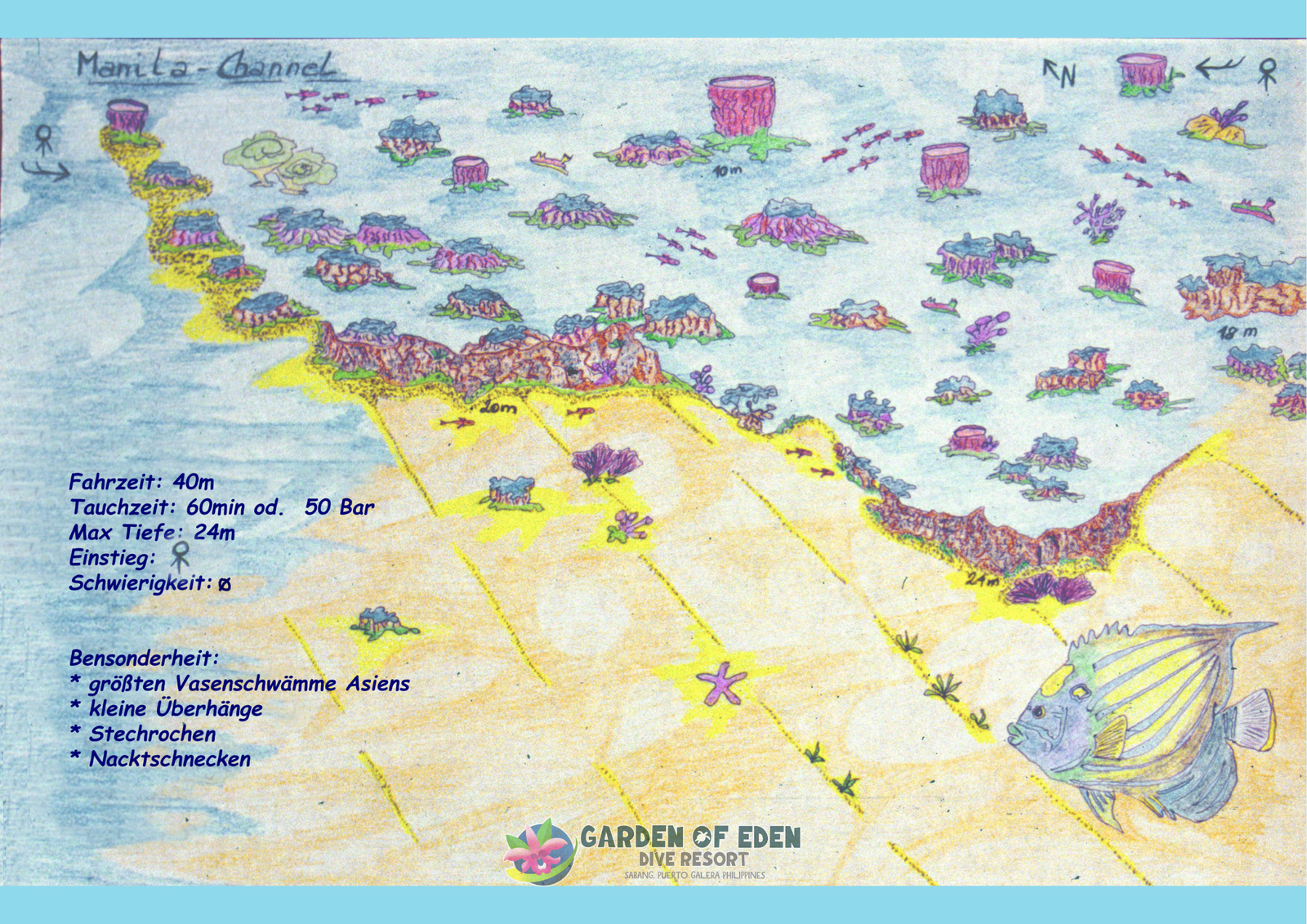
2. MONATNI
Location: West of Garden of Eden Dive Resort
Access: Approx. 20 minutes by boat
Diving experience: From beginners to experienced divers
Average depth: 6 m
Maximum depth: 12 m
Known for its stunning sandy underwater landscape and diverse marine life, it’s perfect for macro enthusiasts and offers an impressive diving experience for both beginners and experienced divers. The dive site is characterized by a diverse mix of nudibranch species.
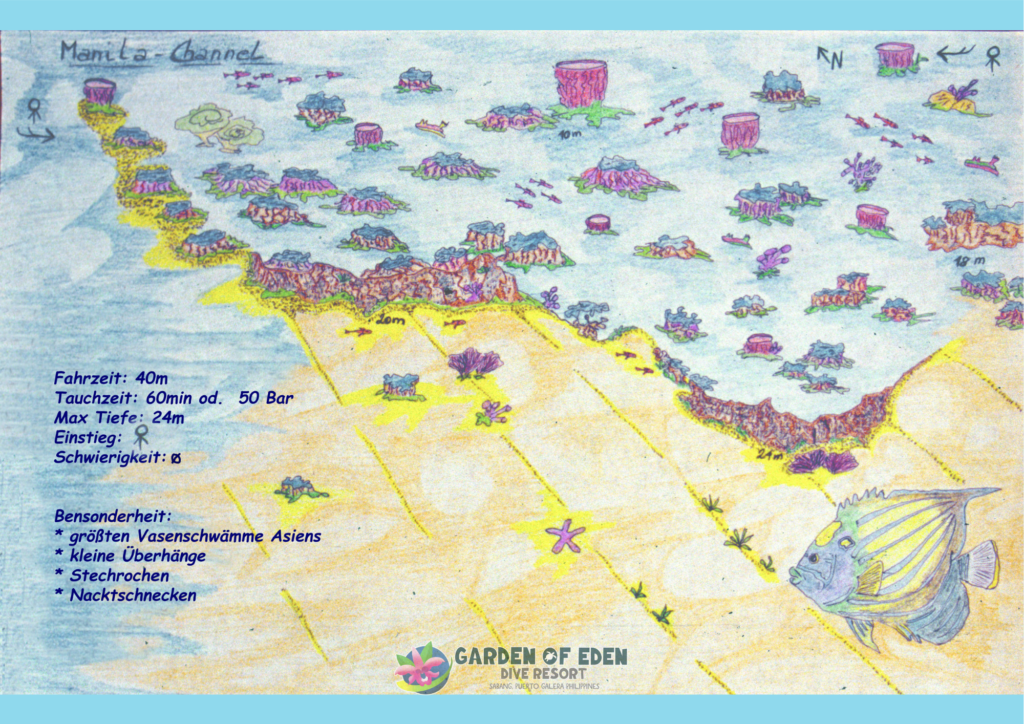
3. BATANGAS CHANNEL
Location: To the west of Garden of Eden Dive Resort
Access: Approx. 17 minutes by boat.
Diving Experience: From beginner to experienced diver
Average Depth: 10 m.
Maximum Depth: 16 m.
With strong tides, you can expect a good drift dive here. At around 14 m, there are countless barrel sponges, some up to 2 m in size. When there is current, you can see schools of barracuda, sweetlips, snapper, and fusiliers. Many reef fish can be found, occasionally stingrays, and sometimes a whitetip reef shark.
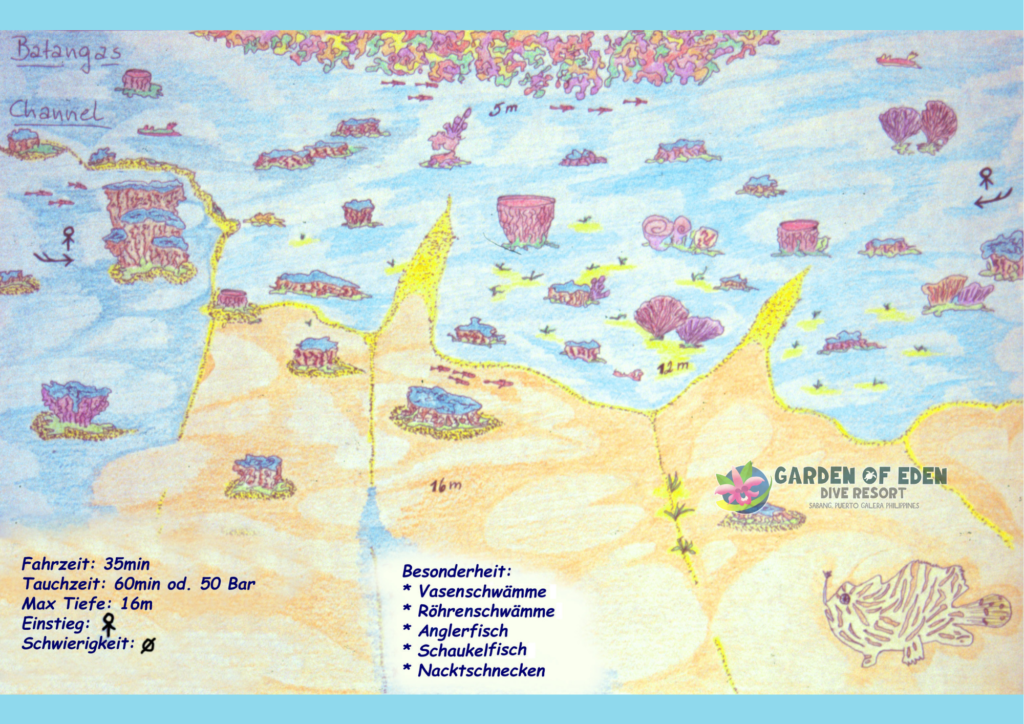
4. LALAGUNA POINT
Location: Off Sabang Beach.
Access: Max. 5 minutes by boat.
Diving experience: From beginners to experienced divers.
Average depth: 12 m.
Maximum depth: 18 m.
A small drop-off point, 12 by 15 m, with many small reef fish, nudibranchs, and feather stars. A very popular night dive site. Good chance of seeing Spanish dancers.
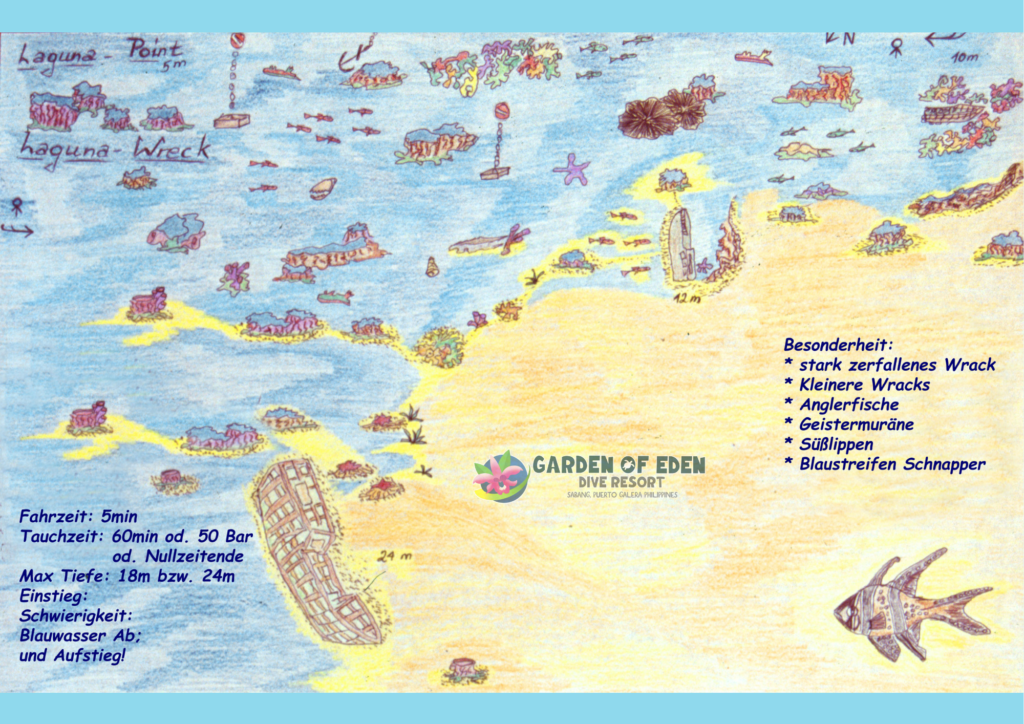
5. LALAGUNA WRECK
Location: Directly in front of Laguna Point.
Access: 5 minutes by boat
Diving experience: From beginners to experienced divers (direct descent to 24 meters)
Average depth: 15 m.
Maximum depth: 26 m.
At a depth of 24 m lie fragments of a 25 m long wooden ship, covered with a wide variety of corals. This makes it an ideal playground for all kinds of scorpionfish, blue-striped snapper, shrimp, and night slugs. Good chance of seeing frogfish.

6. OLD HOUSE REEF
Location: Right on the doorstep
Access: Max. 5 minutes by boat
Diving experience: From beginners to experienced divers
Average depth: 10 m
Maximum depth: 20 m
Three small wrecks, each around 20 meters long, in various stages of decay. Home to countless mollusks and crustaceans. Surrounded by resident bats and surgeonfish. A photographer’s paradise, especially during night dives.
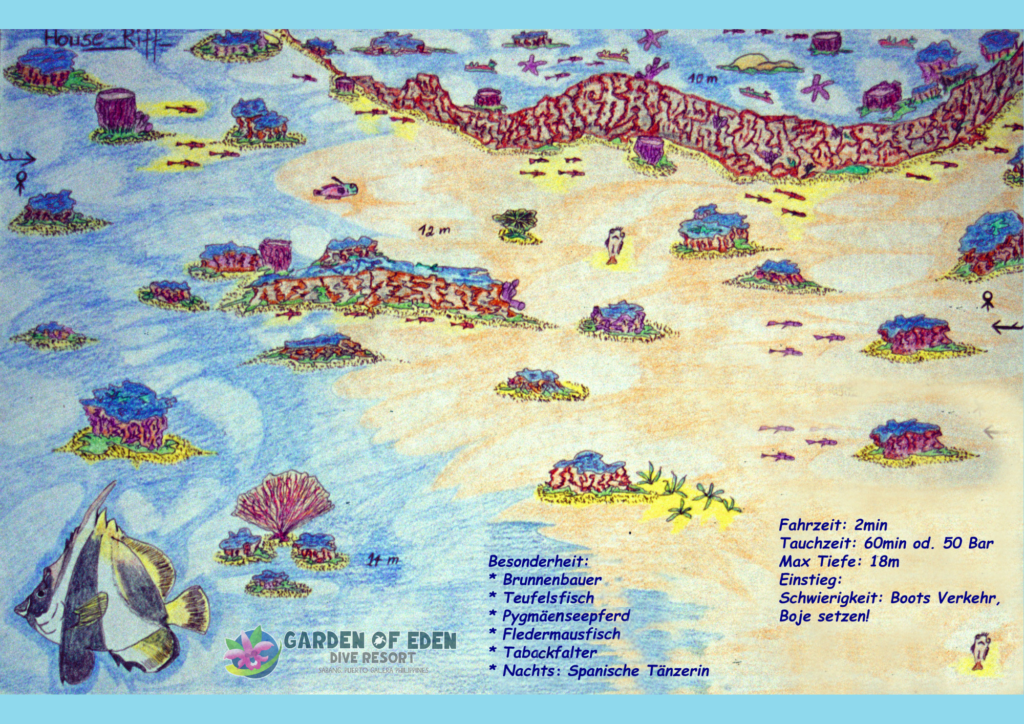
7. SABANG WRECKS
Location: Right on the doorstep
Access: Max. 5 minutes by boat
Diving experience: From beginners to experienced divers
Average depth: 10 m
Maximum depth: 20 m
Three small wrecks, each around 20 meters long, in various stages of decay. Home to countless mollusks and crustaceans. Surrounded by resident bats and surgeonfish. A photographer’s paradise, especially during night dives.
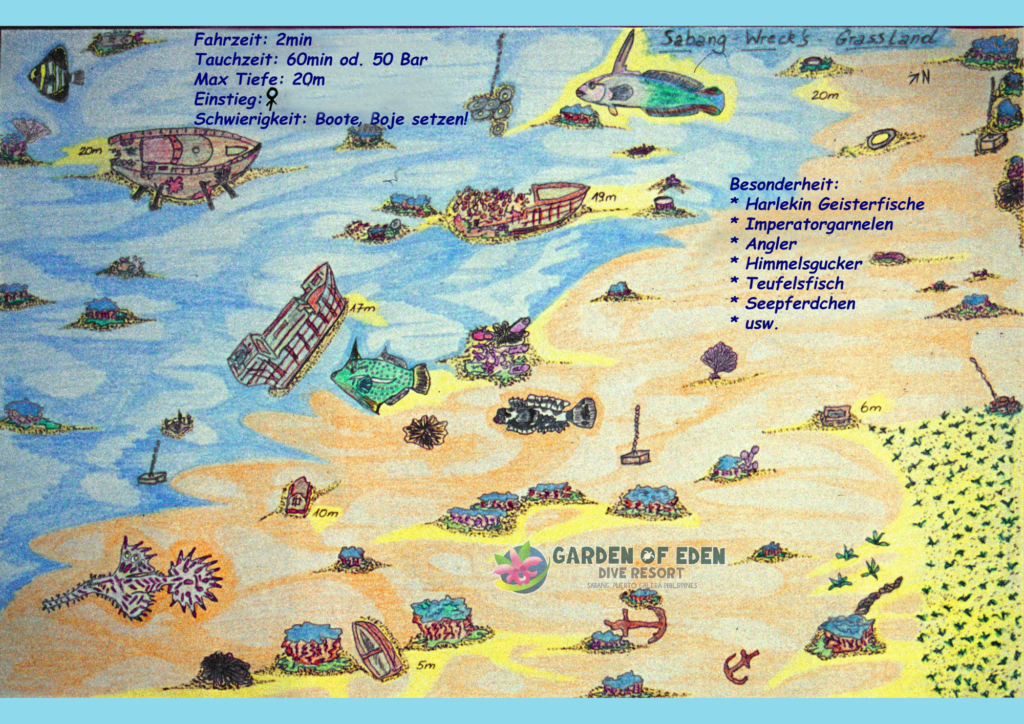
8. GRASSLAND
Location: Directly in front of the dive center
Access: One minute by boat.
Conditions: Mostly calm with little current.
Average depth: 10 m.
Maximum depth: 20 m.
The ideal dive site for macro enthusiasts. All the rarities of note and reputation can be found here. Frogfish, harlequin ghost pipefish, seahorses, and giant winged fishes—and that’s just the beginning.

9. SABANG POINT
Location: Right on the doorstep
Access: Max. 5 min.
Conditions: Mostly calm with light currents.
Average depth: 10 m.
Maximum depth: 20 m.
A beautiful wall dropping to 22 m, with hard and soft corals, fish, and other invertebrates. A ridge rising from the wall to 5 m is covered with even more corals and colorful feather stars.
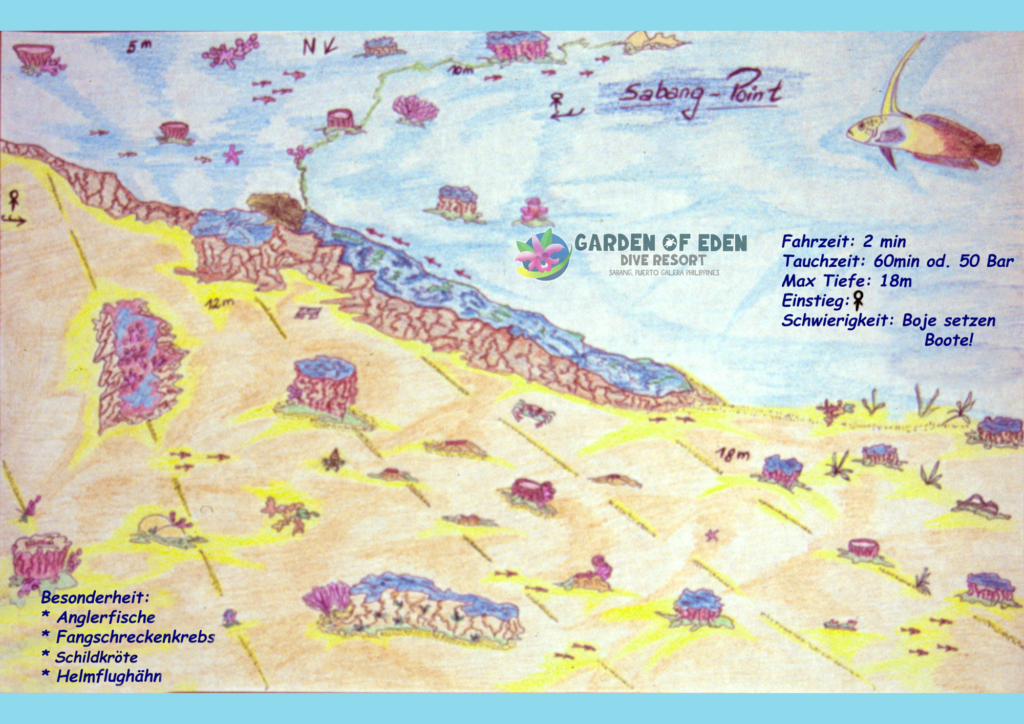
10. SABANG WALL
Location: On Sabang Beach.
Access: Approx. 2 minutes by boat to the east.
Conditions: Mostly calm with a slight current. Visibility up to 20 m.
Average depth: 15 m.
Maximum depth: 24 m.
Small, beautifully overgrown wall with soft and hard corals, some gorgonians, plenty of small fish, and a good chance of seeing turtles.
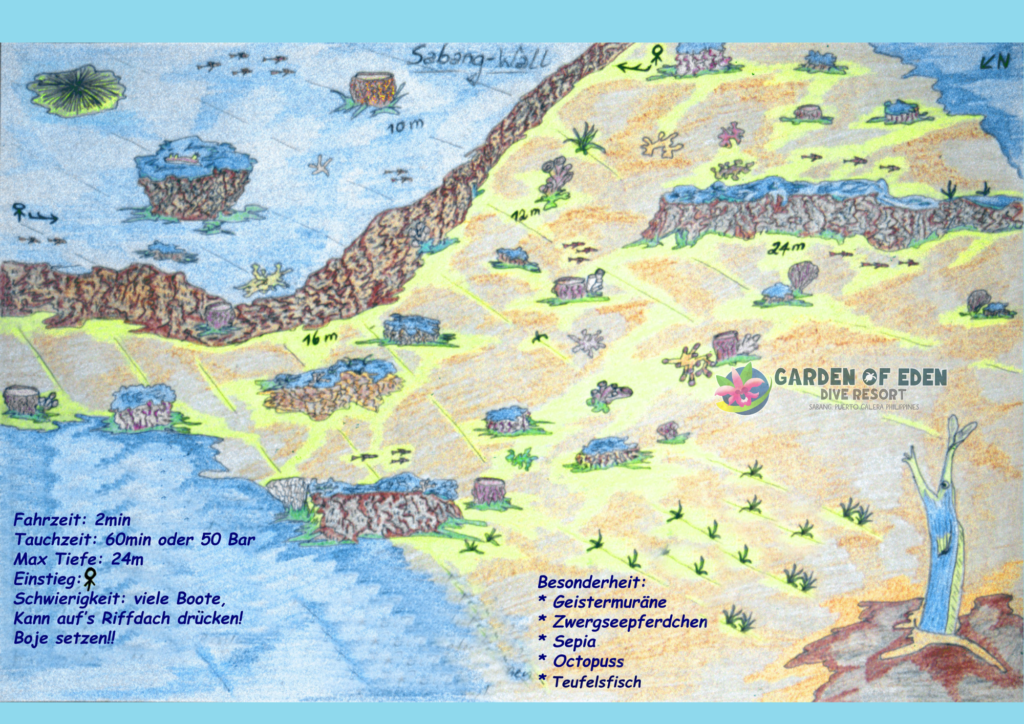
11. MONKEY WRECK
Location: East of Sabang Point
Access: Approx. 5 minutes by boat to the east
Conditions: Generally calm, but slight currents possible. Visibility up to 20 m.
Average depth: 35 m.
Maximum depth: 40 m.
A 20-meter-long cargo ship, sunk in 1993, lies at a depth of 40 m. It is somewhat dangerous because it rolls in the swell. It already has some inhabitants, including a school of batfish.
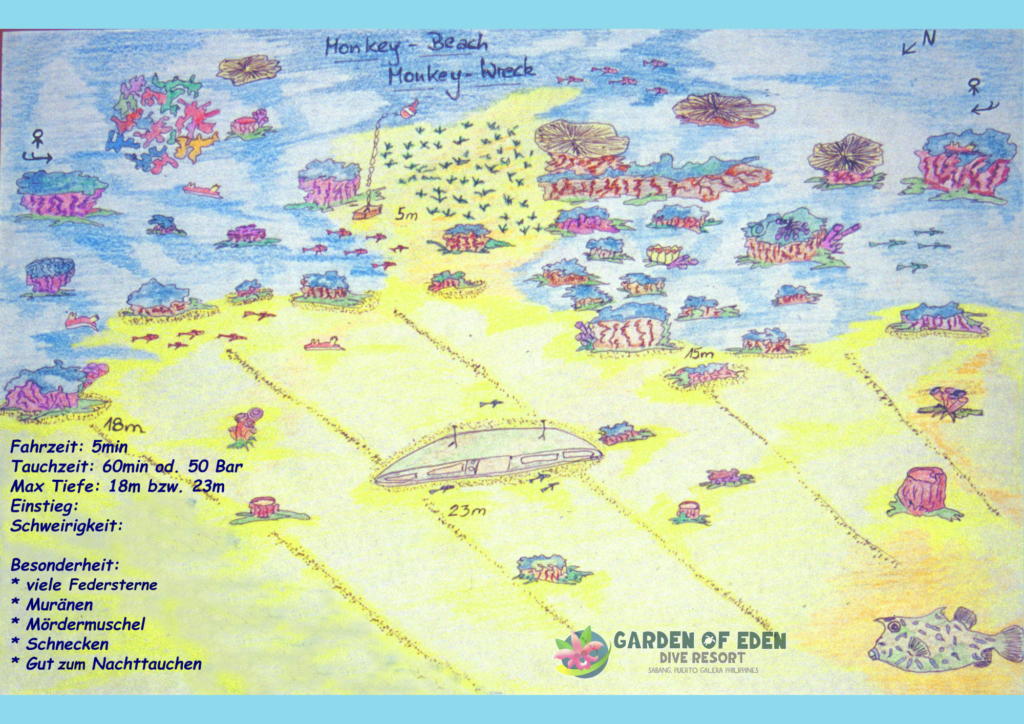
12. NEW MONKEY WRECK
Location: Off Monkey Beach
Access: Approx. 5 minutes by boat
Conditions: Generally calm, often less current than at sites further east
Average depth: 15 m
Maximum depth: 20 m
Sunk in 2001, this approximately 20 m long steel boat quickly became home to multicolored feather stars and large lionfish.
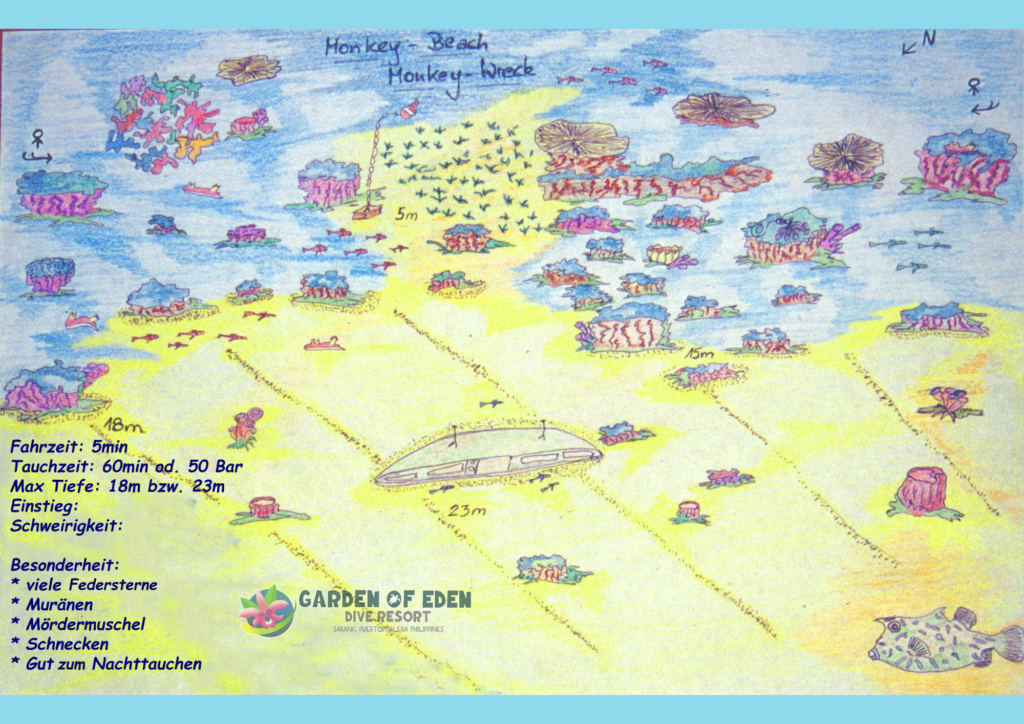
13. MONKEY BEACH
Location: In front of Monkey Beach
Access: Approx. 5 minutes by boat east to Monkey Beach.
Conditions: Generally calm, often less current than at the spots further east. Visibility up to 20 m.
Average depth: 12 m.
Maximum depth: 18 m.
A beautiful coral slope down to 18 m offers easy diving, also suitable for beginners. You’ll find small coral blocks with feather stars, nudibranchs, and many small reef fish, as well as starfish, sea urchins, and sea cucumbers on the sand. Also suitable for night dives.
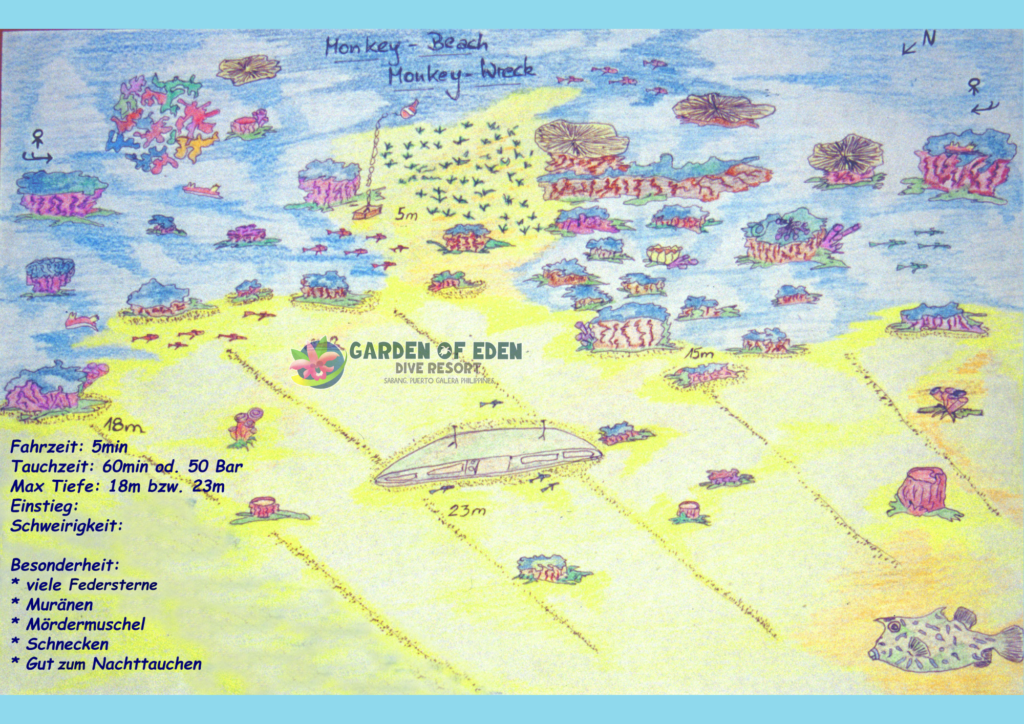
14. ERNIE’S CAVE
Location: East of Monkey Beach
Access: Approx. 8 minutes by boat.
Conditions: Generally calm, moderate current, but can get rough in strong currents. Visibility up to 20 m.
Average depth: 22 m.
Maximum depth: 30 m.
There are two small caves at 22 and 27 m. There is a lively fish life here, with schools of surgeonfish, longnose surgeonfish, jacks, snappers, and fusiliers. Whitetip reef sharks are also occasionally seen. Beautiful hard and soft corals, sponges, small gorgonians, and feather stars complete the picture.
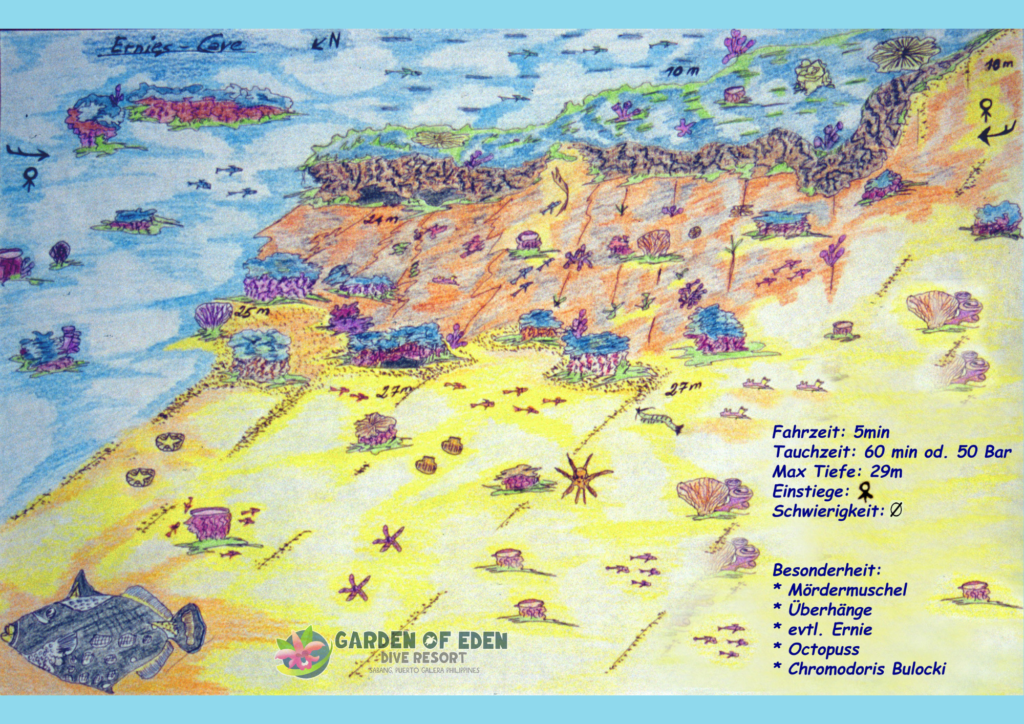
15. DUNGON WALL
Location: Approx. 10 minutes by boat east of Sabang Beach.
Conditions: Mostly choppy, but can get very rough, with strong currents. Visibility up to 20 m.
Average depth: 18 m.
Maximum depth: 24 m.
Easy and varied dive site with steep drops from 12 to 24 m, many beautiful soft corals, colorful feather stars, large tuna, and a wide variety of reef fish.

16. DUNGON WRECK
Location: The first point west of Escarceo Point.
Access: Approx. 15 minutes by boat east to Wreck Point.
Conditions: Usually choppy on the surface with strong currents, but it can also get very rough with extreme currents. Visibility at high tide up to 25 m.
Average depth: 25 m.
Maximum depth: 30 m.
There is a wreck on the beach at a depth of 27 m. A gentle sandy slope with large blocks of hard coral and some rocks is in front of you. Many small angelfish and butterflyfish, damselfish, parrotfish, groupers, surgeonfish, triggerfish, trumpetfish, lionfish, and anthias live here. There are also pufferfish, jacks, sweetlips, young sharp-headed batfish and moray eels, on the sand lizardfish, goatfish, gobies, leopard sea cucumbers and starfish, and everywhere colourful feather stars

17. WRECK POINT
Location: Approx. 12 minutes east of Sabang Beach.
Conditions: Mostly calm with moderate current, but can also get rough.
Average depth: 13 m.
Maximum depth: 20 m.
Sloping reef slope with purple gorgonians and plenty of small fish. Beautiful coral blocks with various nudibranchs are found in the 5-10 meter range.
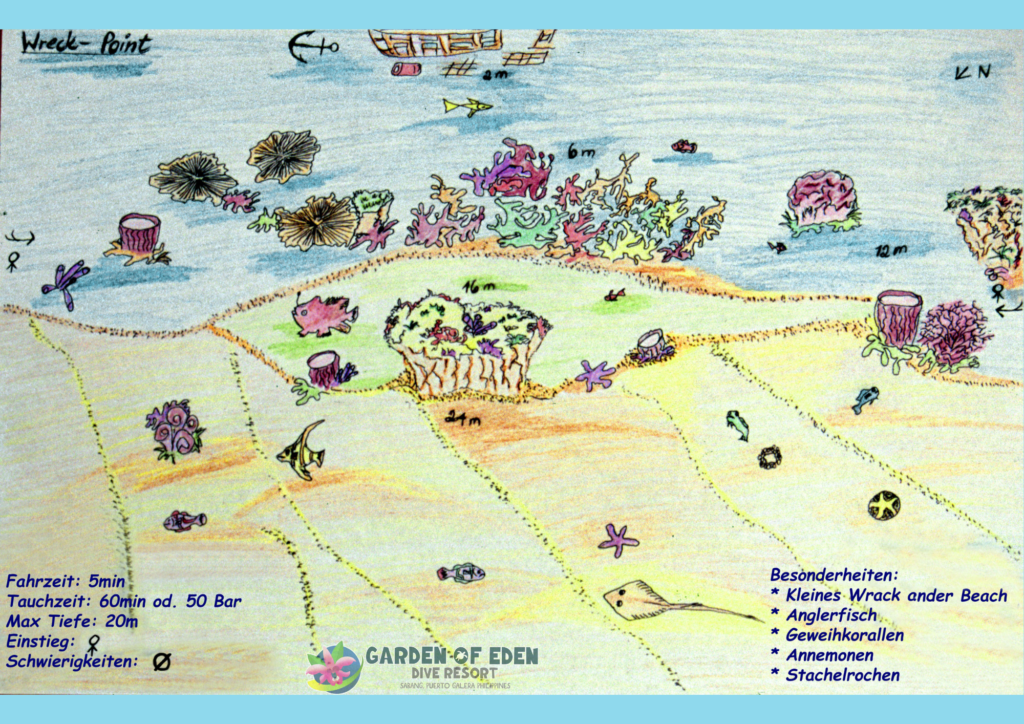
18. WEST ESCARCEO
Location: Directly west of Escarceo Point and Hole in the Wall.
Access: Approx. 20 minutes by boat east.
Conditions: Usually choppy at the surface with strong currents, but it can get very rough with extreme currents. Visibility at high tide up to 25 m.
Average depth: 18 m.
Maximum depth: 27 m.
On a gentle slope from 9 by 27 m, you will find many large coral blocks on the sand, as well as some very large table corals, beautiful coral blocks with colorful spiral tube worms and feather worms, blue and white sponges, blue and yellow sea squirts, many species of nudibranchs, flatworms, sea cucumbers, starfish, and colorful feather stars.
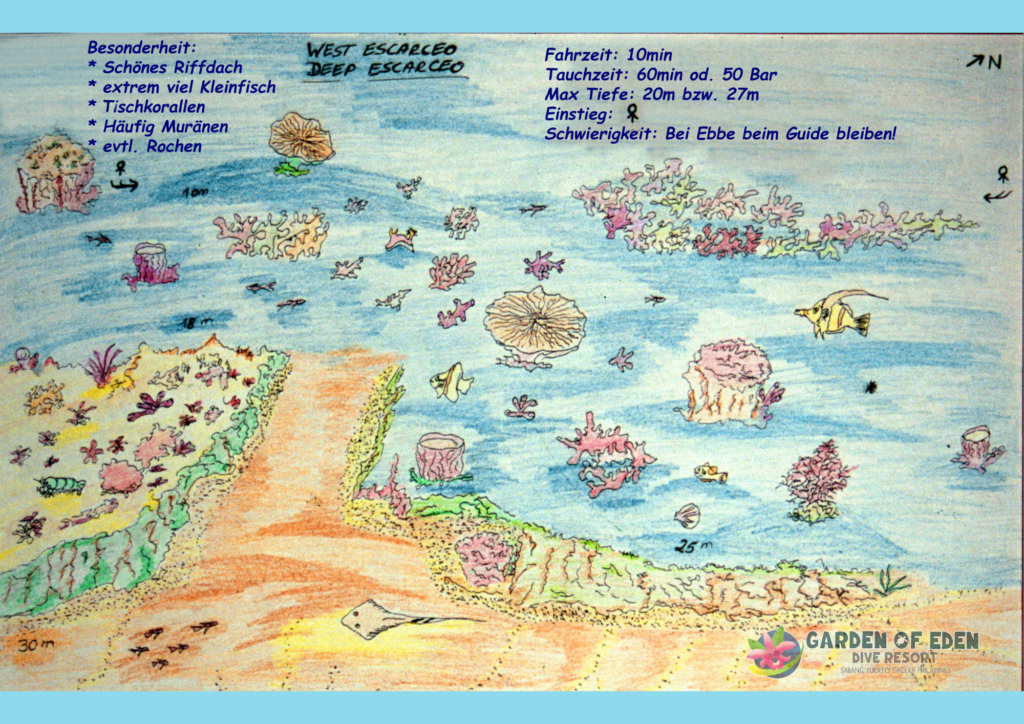
19. HOLE IN THE WALL
Location: Directly west of Escarceo Point.
Access: Approximately 20 minutes by boat east. A local guide is required to find the area due to the currents.
Conditions: Mostly choppy on the surface with strong currents, but very rough seas with extreme currents are also possible. Visibility up to 25 m.
Average depth: 19 m.
Maximum depth: 19 m
Diving against the current, you descend 9 m to a unique field of table corals. You descend several steps, approximately 3 m high, and reach the hole in the wall at a depth of 12 m. The hole is approximately 1.5 x 0.8 m in size, covered with colorful sponges and feather stars, and leads to the canyons.
It teems with small reef fish, angelfish, and butterflyfish. Giant male gannets guard their clutches; there are black-and-white parrotfish, bannerfish, angelfish, butterflyfish, and moorish shad, snappers, sweetlips, trumpetfish, and pufferfish, broomtail filefish, lionfish, and jacks, as well as a few large tuna and groupers. Various species of nudibranchs live on the walls, starfish and sea cucumbers on the sand, and moray eels in the crevices.
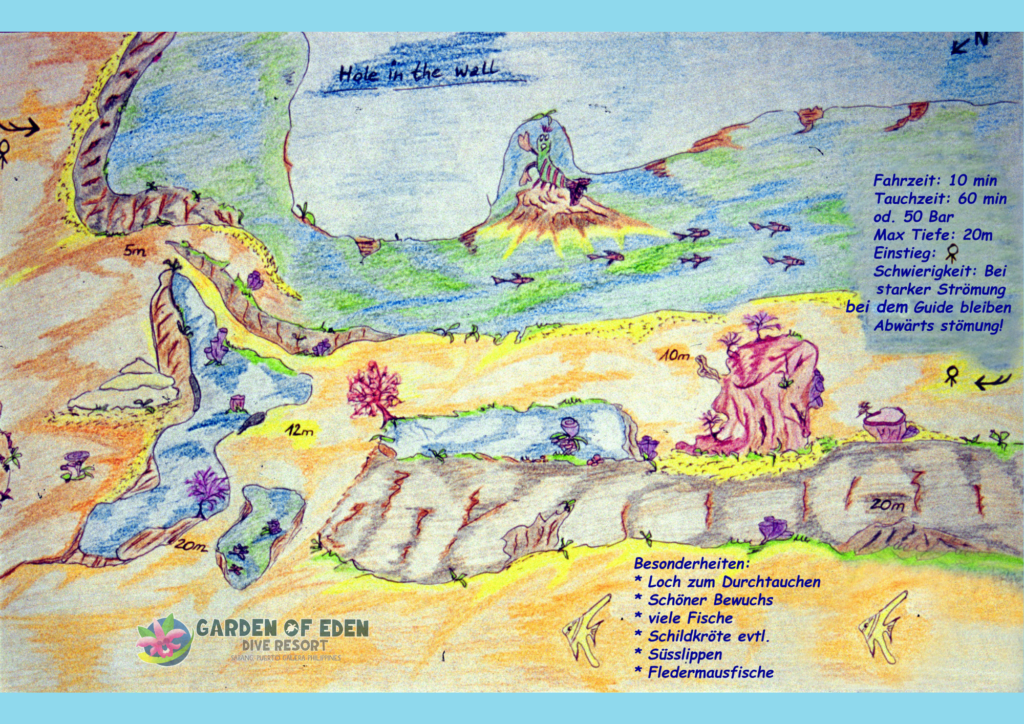
20. THE CANYONS
Location: Northeast of Escarceo Point.
Access: Approx. 23 minutes by boat.
Conditions: Mostly choppy on the surface with strong currents, but very rough seas with extreme currents are possible. Best dived at high tide, when visibility is possible down to 30 m.
Average depth: 25 m.
Maximum depth: 30 m.
Also suitable for advanced divers with a good guide who knows the currents that will carry you to your destination. You drift past the Hole in the Wall and over some small drop-offs with soft corals and sponges. There are several smaller canyons where photographers can briefly seek shelter. Most importantly, however, is the abundance of fish – simply everything is there, including six-banded angelfish, peacock angelfish, and emperor angelfish. In the deeper water, there are some large sponges and gorgonians. Only for experienced divers with a love of currents. (For experienced divers only)
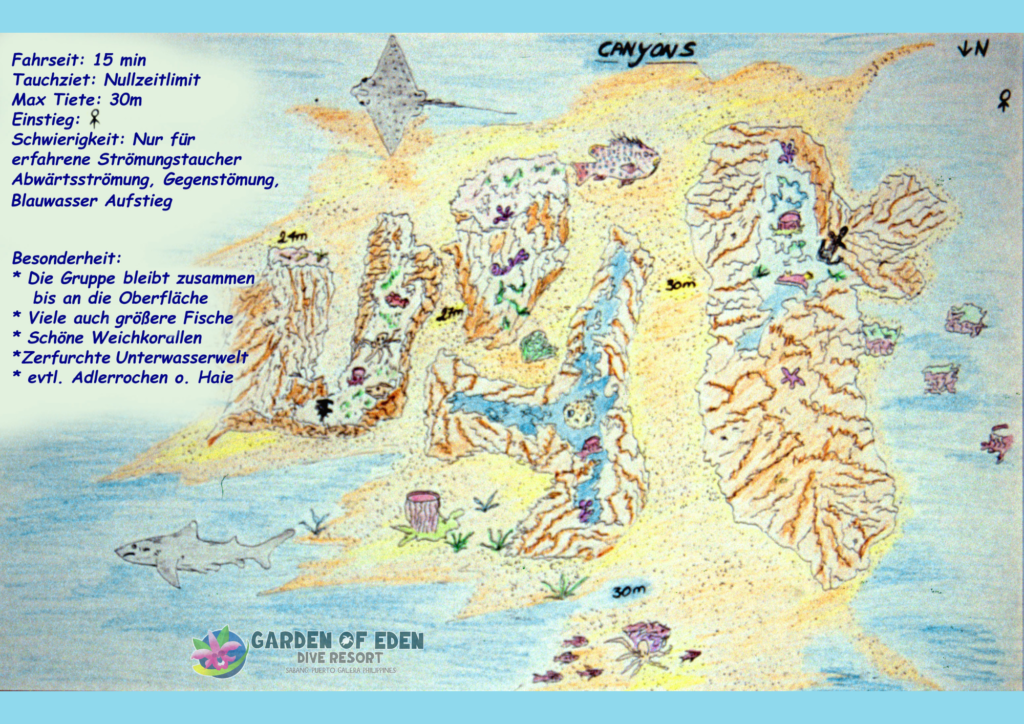
21. SHARK CAVE
Location: East of Escarceo Point.
Access: Approx. 25 minutes by boat east.
Conditions: Very rough with extreme currents. Visibility up to 20 m.
Average depth: 25 m.
Maximum depth: 27 m.
Shark Cave is a 30 m long overhang at a depth of 29 m. It is 1 m high at the entrance but narrows to 15 cm after 4 m. Whitetip reef sharks rest here during the day. Nearby is a large boulder with soft corals, brown snub corals, small gorgonians, and barrel sponges.

22. THE ATOLL
Location: Southeast of Escarceo Point.
Access: Approx. 25 minutes by boat east around Escarceo Point to the south of Shark Cave.
Conditions: Mostly choppy on the surface, with moderate currents, but it can get very rough, visibility up to 25 m.
Average depth: 24 m.
Maximum depth: 33 m.
An atoll-shaped, 15 m wide rock rises from 33 to 21 m. It is very rich in fish, with some lionfish mainly under the overhangs and blue-spotted stingrays in the crevices and on the sand.
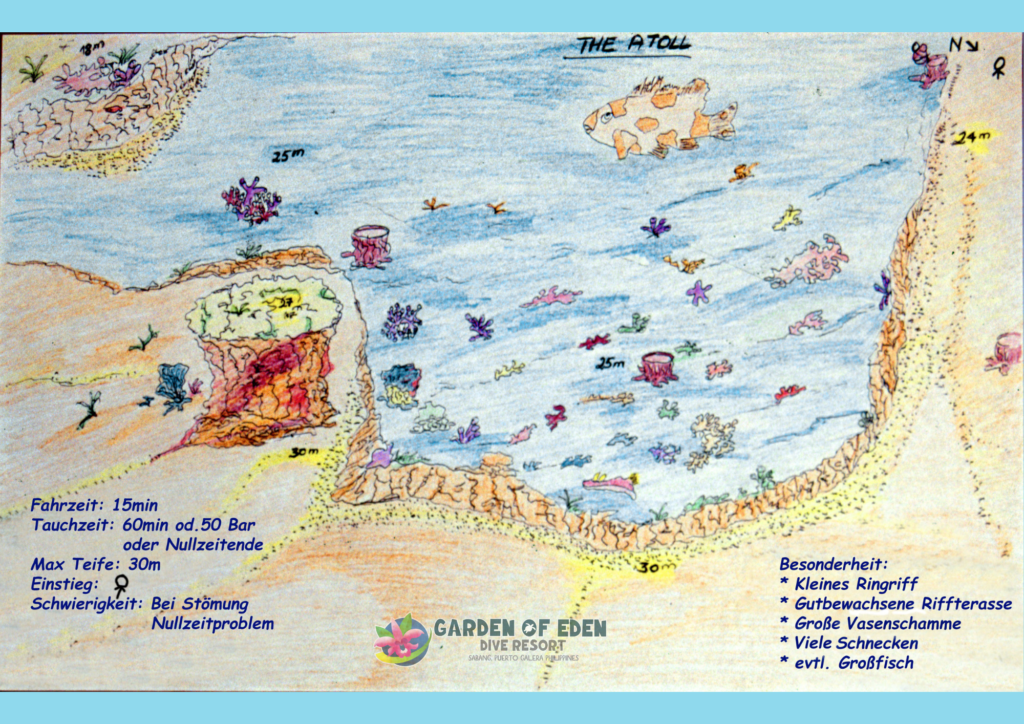
23. PINK WALL
Location: East of the southeast corner of the southern tip of Esarceo Point.
Access: Approx. 25 minutes by boat east.
Conditions: Mostly calm with a gentle current, but can get rough with strong currents. Dive at high tide, when visibility is possible down to 20 m.
Average depth: 10 m.
Maximum depth: 15 m.
Overhanging wall at 10 m with pink soft and cup corals. Coming from “Hole in the Wall,” you first swim through a unique field of white whip corals.

24. KILIMA STEPS
Location: South of the southeast promontory of Escarceo Point.
Access: Approximately 27 minutes by boat east around Escarceo Point to the south side of the Pink Wall.
Conditions: Mostly choppy at the surface with a gentle current, but it can get very rough with extreme currents. Visibility up to 20 m.
Average depth: 20 m.
Maximum depth: 27 m.
These small, stepped drop-offs are best dived at low tide. There are many beautiful hard and soft corals, other invertebrates, and fish.
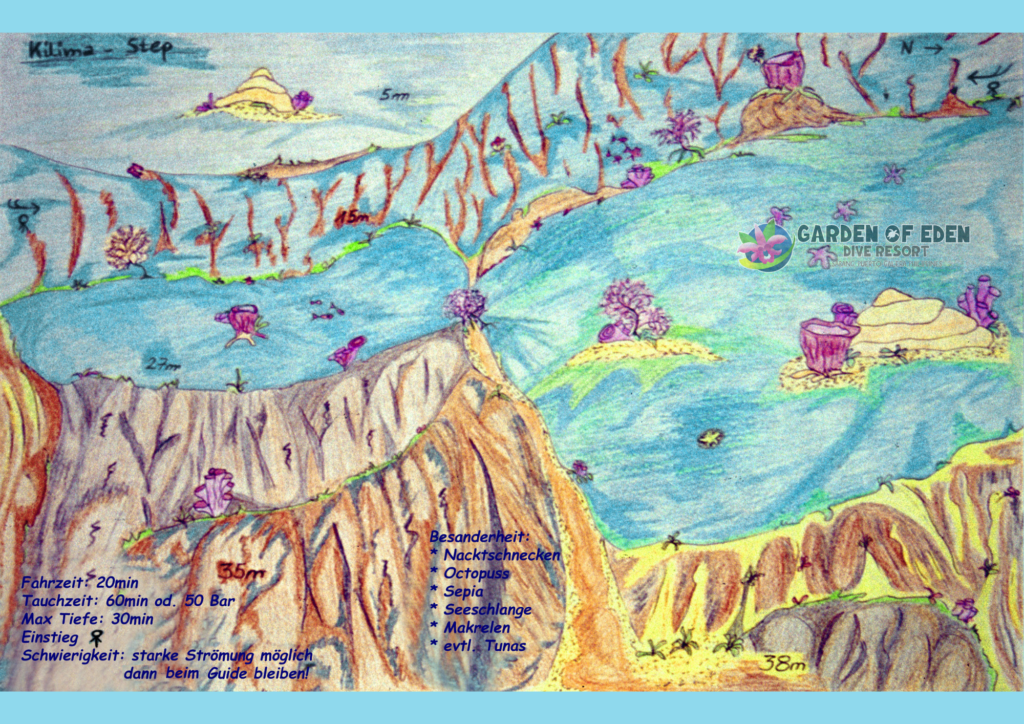
25. KILIMA WALL
Location: South of the southeastern promontory of Escarceo Point.
Access: Approx. 27 minutes by boat east around Escarceo Point.
Conditions: Mostly light to moderate current, but strong currents are also possible.
Average depth: 18 m. Maximum depth: 25 m.
Gradually sloping reef with a small drop-off point. Particularly colorful during current, when all the different colored soft and stony corals display their polyps. All species of moray eels and scorpionfish can be found here. Also striking are the schools of surgeonfish.

26. SINANDIGAN WALL
Location: Off the headland at the southernmost point of Escarceo Point.
Access: Approx. 28 minutes by boat east around Escarceo Point to the lower southeast corner.
Conditions: Usually choppy at the surface with strong currents, but can get very rough with extreme currents. Visibility up to 25 m.
Average depth: 20 m.
Maximum depth: 30 m.
A true wall dropping down to 40 m, with various corals and numerous nudibranchs, as well as larger fish species such as snapper, jacks, large tuna, barracuda, and the occasional whitetip reef shark.
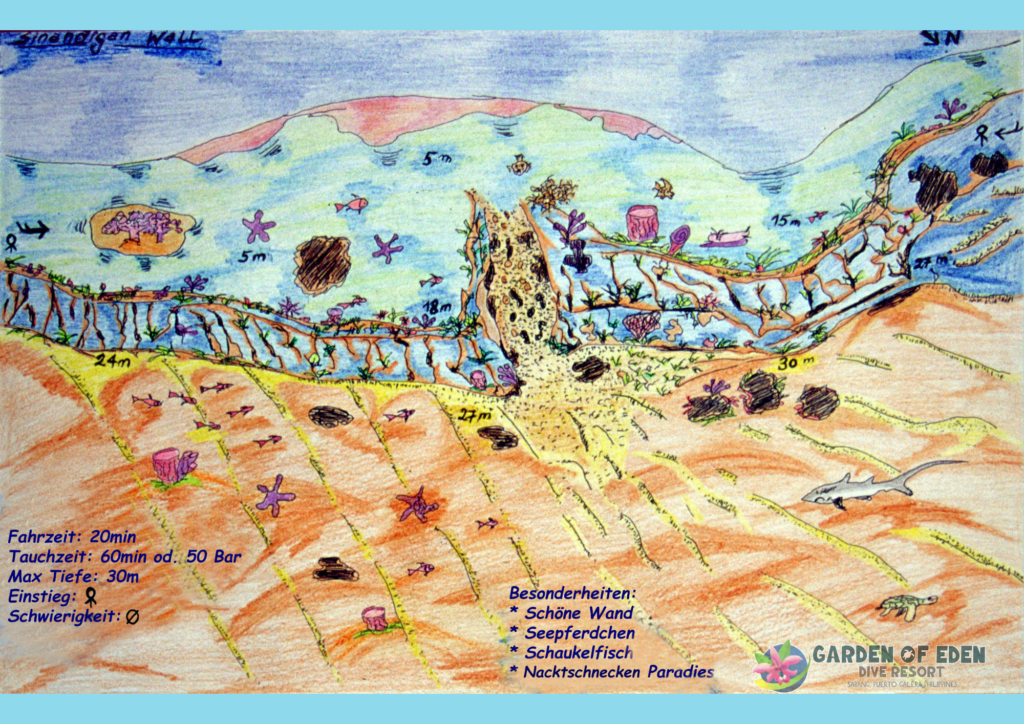
27. TURTLE ROCK
Location: Off the headland at the southernmost point of Escarceo Point.
Access: Approx. 28 minutes by boat east around Escarceo Point to the lower southeast corner.
Conditions: Usually choppy on the surface with strong currents, but it can get very rough with extreme currents. Visibility up to 25 m.
Average depth: 18 m. Maximum depth: 40 m.
Large, beautifully overgrown coral block. Highest point 27 m. The block has small white sea fans, a multitude of yellow sea cucumbers, scorpionfish, and, with very, very good luck, a thresher shark might pass by. The dive ends in the coral garden of Sinandigan.
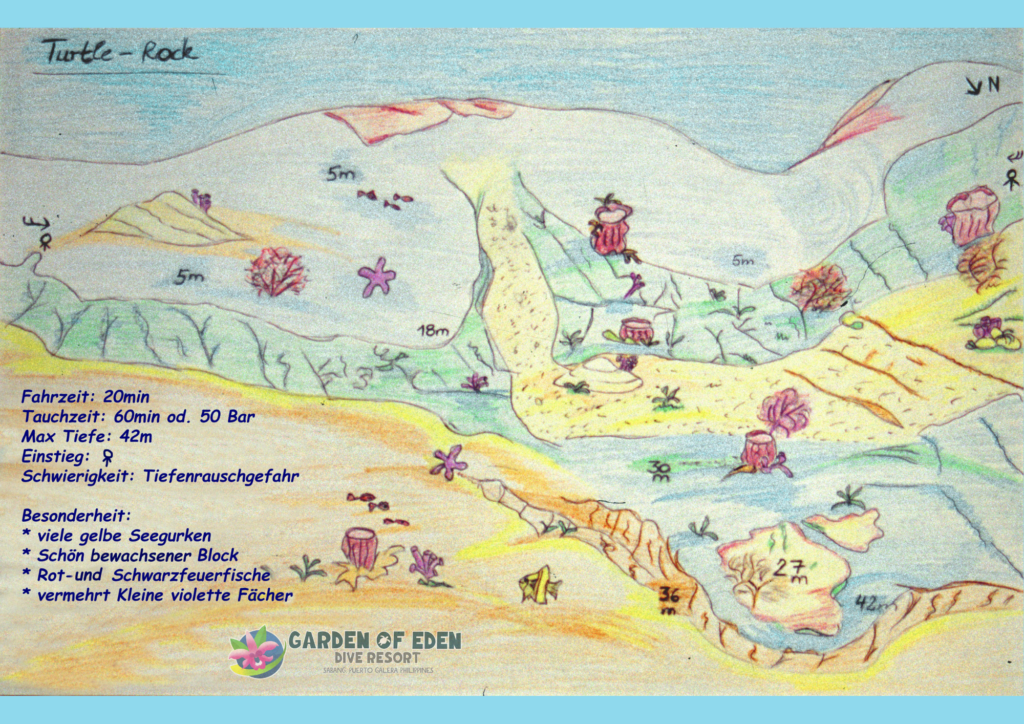
28. CORAL COVE
Location: Off the headland at the southernmost point of Escarceo Point.
Access: Approx. 29 minutes by boat east around Escarceo Point.
Conditions: Usually only light to moderate current.
Average depth: 13 m.
Maximum depth: 26 m.
Best spot for blue-spotted stingray encounters. Cuttlefish are often seen, and the rare cuttlefish pepperfish are also occasionally seen.

29. THE BOULDERS
Location: The next point south of Escarceo Point.
Access: Approximately 30 minutes by boat east around Escarceo Point to the next point south of Pink Wall.
Conditions: Mostly choppy on the surface with a gentle current, but can become very rough with strong currents. Visibility up to 15 m.
Average depth: 20 m.
Maximum depth: 27 m.
Several large rocks form overhangs, tunnels, and windows up to 24 m deep. Large fish are often seen here.
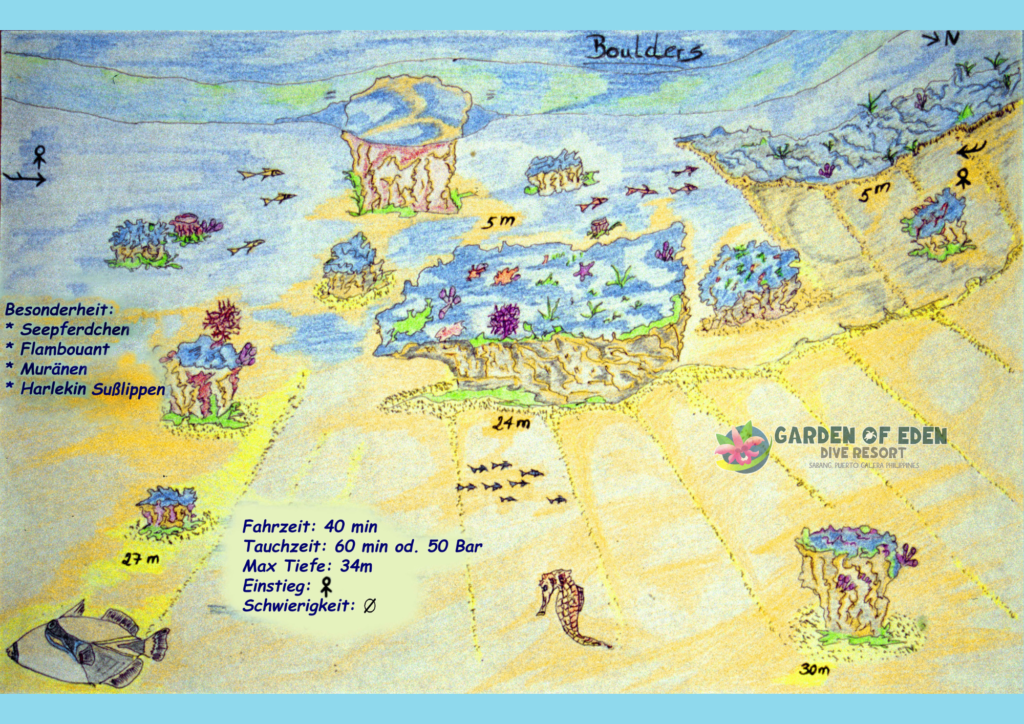
30. M/V ALMA JANE
Location: Directly in front of Laguna Point
Access: Approx. 5 minutes by boat
Conditions: For intermediate to advanced divers (free descent to 30 meters)
Average depth: 20 m.
Maximum depth: 30 m.
The steel wreck, which was sunk in early March 2003, lies 30 meters deep. It is 35 meters long and was originally two stories high. However, it soon began to deteriorate. Today, it is already extremely well-vegetated and has many resident inhabitants. Due to its somewhat remote location from the reef, mackerel, schools of tuna, and smelt can often be seen here. With light currents, it is possible to end the dive at Laguna Point.

31. DRY DOCK
Location: West of Garden of Eden Dive Resort
Access: Approx. 6 minutes by boat
Conditions: For intermediate to advanced divers (It’s quite a long swim)
Average depth: 15 m
Maximum depth: 30 m
Submerged steel floating dock, at a depth of 22 to 30 meters. Beautiful, covered with gorgonian, soft corals, and small fan corals. Plenty of small creatures, such as nudibranchs, shrimp, and crabs. Various species of schooling fish, such as snapper and sweetlips, are found. Difficult to navigate in currents and only for current lovers.
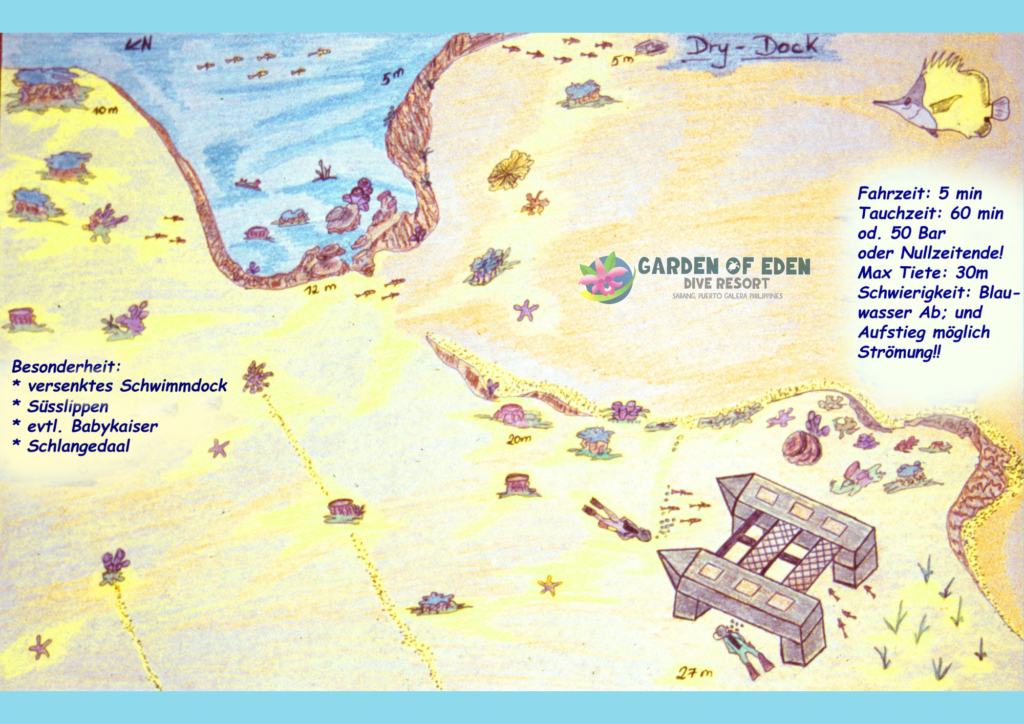
32. THE HILL
Location: West of Garden of Eden Dive Resort
Access: Approx. 20 minutes by boat
Conditions: For intermediate to advanced divers
Average depth: 5 m
Maximum depth: 15 m
The dive begins at the top of a hill, just 5 meters below the surface. This area is characterized by coral heads, sponges, large green tree corals, and lush fields of soft corals, creating an impressive underwater landscape.
33. DALARUAN POINT
Location: West of Garden of Eden Dive Resort
Access: Approx. 20 minutes by boat
Conditions: For intermediate to advanced divers.
Average depth: 15 m.
Maximum depth: 25 m.
Dalaruan Point is located in Puerto Galera and is accessible by boat from various points along the coast. It is a popular dive site due to its proximity and the diversity of marine life.
Dalaruan Point is an excellent dive site that caters to everyone—from beginners to experienced divers—with an abundance of marine life and beautiful underwater landscapes. Whether you’re looking for quiet dives or more adventurous dive sites, it’s a place worth exploring.
Garden of Eden Dive Resort in Sabang, Puerto Galera offers a perfect mix of thrilling dives, simple accommodations, and a friendly, laid-back atmosphere.
-
Sabang Boulevard, Puerto Galera,
Oriental Mindoro, 5203 Philippines - dive@goeresort.com
- +63 967 407 4407 (PH)
- +49 151 267 321 37 (DE)